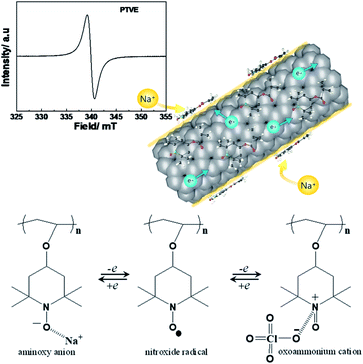Binder-free organic cathode based on nitroxide radical polymer-functionalized carbon nanotubes and gel polymer electrolyte for high-performance sodium organic polymer batteries
- Journal
- Journal of Materials Chemistry A
- Vol
- 8
- Page
- 17980
- Year
- 2020
The organic polymer battery is a promising alternative to the lithium ion battery, however its various properties need to be improved. In this study, we demonstrate an advanced organic radical battery (ORB) using a cathode based on poly(2,2,6,6-tetramethylpiperidine-4-yl-1-oxyl vinyl ether) (PTVE) and a microporous gel polymer electrolyte based on electrospun polyimide membrane. To improve upon the low electrical conductivity of PTVE, it is functionalized on carbon nanotubes (CNTs) by a dissolution–diffusion process. The PTVE-functionalized CNTs have a π–π* interaction between the two components, and could be formed into a dense electrode with reasonable porosity. The gel polymer electrolyte with the desired microporosity is also highly compatible. As a result, Na-ion organic full cells using the PTVE–CNT composite electrode, gel polymer electrolyte, and hard carbon anode show good rate capability and stable cycling. The battery achieves discharging capacities of 128.6 and 68.2 mA h g−1 at 0.5C and 10C with 100% coulombic efficiency and no self-discharge. Hence, this combination of composite electrode and gel polymer electrolyte leads to a safe, lightweight, and environmentally benign sodium battery with high power-rate capability for various applications.

